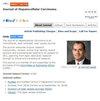增强模式图用于肝硬化患者肝细胞癌的早期检测
IF 4.2
3区 医学
Q2 ONCOLOGY
引用次数: 0
摘要
背景和目的:目前准确描述肝脏病变恶性进展风险的方法有限。增强模式图(EPM)测量基于体素的实质均方根偏差(RMSD),以及恶性病变中增强的对比度与噪声比(CNR)。本研究探讨了如何利用 EPM 来区分 HCC 和肝硬化实质,以及有无良性病变:方法:对接受磁共振成像监测的肝硬化患者进行前瞻性研究。病例(48 例)定义为在监测期间出现 HCC 的 LI-RADS 3 和 4 病变患者。对照组(n=99)为有或没有LI-RADS 3和4病变但未发展为HCC的患者。病例和对照组之间肝实质的手动和自动 EPM 信号通过交叉验证在独立的患者集上进行了定量验证,手动方法避免了带有伪影或血管的肝实质:通过手动 EPM,RMSD 0.37 被确定为从诊断前扫描(中位时间间隔为 6.8 个月)中有病变和无病变的背景实质中区分进展为 HCC 的病变的临界值,其曲线下面积 (AUC) 为 0.83(CI:0.73- 0.94),灵敏度、特异性和准确性分别为 0.65、0.97 和 0.89。在诊断扫描时,手动 EPM 的灵敏度、特异性和准确性分别为 0.79、0.93 和 0.88,AUC 为 0.89(CI:0.82- 0.96)。病例和对照组中未发展为 HCC 的背景实质的 EPM RMSD 信号相似(病例 EPM:0.22 ± 0.08,对照组 EPM:0.22 ± 0.09,P=0.8)。自动 EPM 的定量结果和性能相似:通过手动 EPM,以 0.37 为临界值可确定 HCC 病例和对照组在诊断 HCC 前约 6 个月的量化差异,准确率为 89%。增强模式图是一种可量化病变信号的成像技术,可用于诊断和监测方法。增强模式图描述了对比增强磁共振成像中恶性和良性肝组织之间可量化的差异。它能放大病变信号,并在监测人群中区分恶性肿瘤。该新型成像技术在单个机构进行了研究,并将病变与肝硬化实质进行了对比分析。未来的工作将包括对 LI-RADS 组别进行进一步的风险分层。研究结果证明,增强模式图利用现有的成像数据,可将肝细胞癌与标准磁共振成像诊断前六个月扫描中存在或不存在良性病变的非癌实质区分开来。该技术引入了一种前瞻性模式来提高诊断准确性和早期发现率,从而改善临床疗效:LI-RADS、核磁共振成像、放射组学、人工智能、肝癌、机器学习本文章由计算机程序翻译,如有差异,请以英文原文为准。
Enhancement Pattern Mapping for Early Detection of Hepatocellular Carcinoma in Patients with Cirrhosis
Background and Aims: Limited methods exist to accurately characterize the risk of malignant progression of liver lesions. Enhancement pattern mapping (EPM) measures voxel-based root mean square deviation (RMSD) of parenchyma and the contrast-to-noise (CNR) ratio enhances in malignant lesions. This study investigates the utilization of EPM to differentiate between HCC versus cirrhotic parenchyma with and without benign lesions.
Methods: Patients with cirrhosis undergoing MRI surveillance were studied prospectively. Cases (n=48) were defined as patients with LI-RADS 3 and 4 lesions who developed HCC during surveillance. Controls (n=99) were patients with and without LI-RADS 3 and 4 lesions who did not develop HCC. Manual and automated EPM signals of liver parenchyma between cases and controls were quantitatively validated on an independent patient set using cross validation with manual methods avoiding parenchyma with artifacts or blood vessels.
Results: With manual EPM, RMSD of 0.37 was identified as a cutoff for distinguishing lesions that progress to HCC from background parenchyma with and without lesions on pre-diagnostic scans (median time interval 6.8 months) with an area under the curve (AUC) of 0.83 (CI: 0.73– 0.94) and a sensitivity, specificity, and accuracy of 0.65, 0.97, and 0.89, respectively. At the time of diagnostic scans, a sensitivity, specificity, and accuracy of 0.79, 0.93, and 0.88 were achieved with manual EPM with an AUC of 0.89 (CI: 0.82– 0.96). EPM RMSD signals of background parenchyma that did not progress to HCC in cases and controls were similar (case EPM: 0.22 ± 0.08, control EPM: 0.22 ± 0.09, p=0.8). Automated EPM produced similar quantitative results and performance.
Conclusion: With manual EPM, a cutoff of 0.37 identifies quantifiable differences between HCC cases and controls approximately six months prior to diagnosis of HCC with an accuracy of 89%.
Plain Language Summary: Current surveillance and diagnostic methods in hepatocellular carcinoma are suboptimal. Enhancement pattern mapping is an imaging technique that quantifies lesion signals and may be useful in diagnostic and surveillance methods. Enhancement pattern mapping describes quantifiable differences between malignant and benign liver tissue on contrast-enhanced MRI. It amplifies lesion signal and distinguishes malignancy in a surveillance population. The novel imaging technique was investigated at single institution and analyzed lesions compared to cirrhotic parenchyma. Future efforts will include further risk stratification across LI-RADS group categories. The results provide evidence that enhancement pattern mapping uses available imaging data to distinguish hepatocellular carcinoma from non-cancerous parenchyma with and without benign lesions on scans six months prior to diagnosis with standard MRI. The technique introduces a prospective modality to improve diagnostic accuracy and early detection with the goal of improving clinical outcomes.
Keywords: LI-RADS, MRI, radiomics, artificial intelligence, liver cancer, machine learning
Methods: Patients with cirrhosis undergoing MRI surveillance were studied prospectively. Cases (n=48) were defined as patients with LI-RADS 3 and 4 lesions who developed HCC during surveillance. Controls (n=99) were patients with and without LI-RADS 3 and 4 lesions who did not develop HCC. Manual and automated EPM signals of liver parenchyma between cases and controls were quantitatively validated on an independent patient set using cross validation with manual methods avoiding parenchyma with artifacts or blood vessels.
Results: With manual EPM, RMSD of 0.37 was identified as a cutoff for distinguishing lesions that progress to HCC from background parenchyma with and without lesions on pre-diagnostic scans (median time interval 6.8 months) with an area under the curve (AUC) of 0.83 (CI: 0.73– 0.94) and a sensitivity, specificity, and accuracy of 0.65, 0.97, and 0.89, respectively. At the time of diagnostic scans, a sensitivity, specificity, and accuracy of 0.79, 0.93, and 0.88 were achieved with manual EPM with an AUC of 0.89 (CI: 0.82– 0.96). EPM RMSD signals of background parenchyma that did not progress to HCC in cases and controls were similar (case EPM: 0.22 ± 0.08, control EPM: 0.22 ± 0.09, p=0.8). Automated EPM produced similar quantitative results and performance.
Conclusion: With manual EPM, a cutoff of 0.37 identifies quantifiable differences between HCC cases and controls approximately six months prior to diagnosis of HCC with an accuracy of 89%.
Plain Language Summary: Current surveillance and diagnostic methods in hepatocellular carcinoma are suboptimal. Enhancement pattern mapping is an imaging technique that quantifies lesion signals and may be useful in diagnostic and surveillance methods. Enhancement pattern mapping describes quantifiable differences between malignant and benign liver tissue on contrast-enhanced MRI. It amplifies lesion signal and distinguishes malignancy in a surveillance population. The novel imaging technique was investigated at single institution and analyzed lesions compared to cirrhotic parenchyma. Future efforts will include further risk stratification across LI-RADS group categories. The results provide evidence that enhancement pattern mapping uses available imaging data to distinguish hepatocellular carcinoma from non-cancerous parenchyma with and without benign lesions on scans six months prior to diagnosis with standard MRI. The technique introduces a prospective modality to improve diagnostic accuracy and early detection with the goal of improving clinical outcomes.
Keywords: LI-RADS, MRI, radiomics, artificial intelligence, liver cancer, machine learning
求助全文
通过发布文献求助,成功后即可免费获取论文全文。
去求助

 求助内容:
求助内容: 应助结果提醒方式:
应助结果提醒方式:


